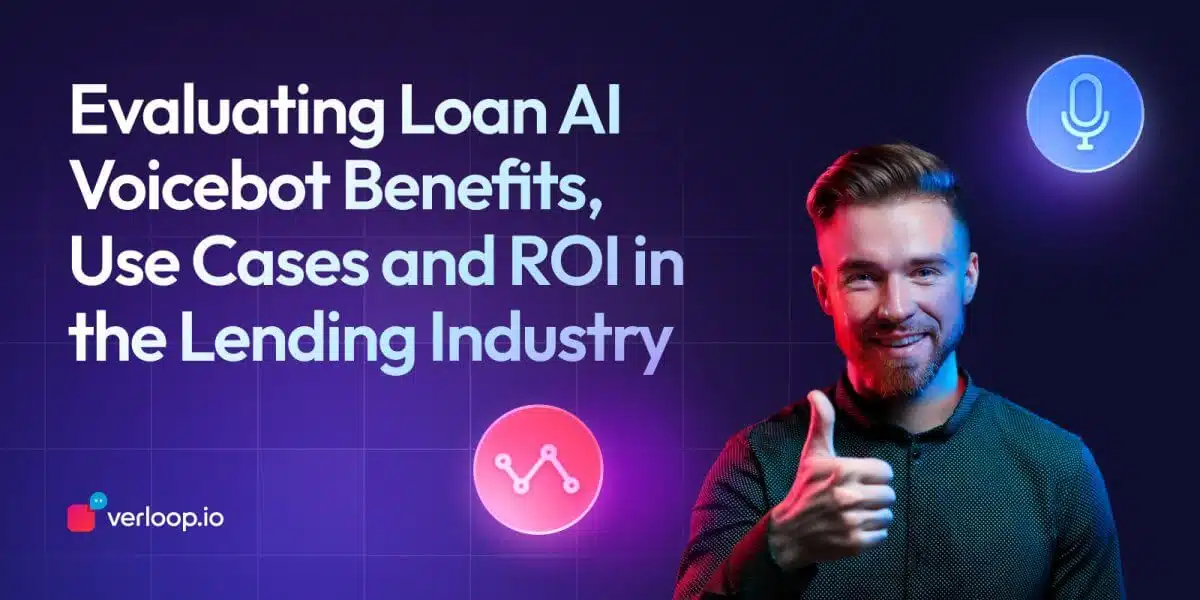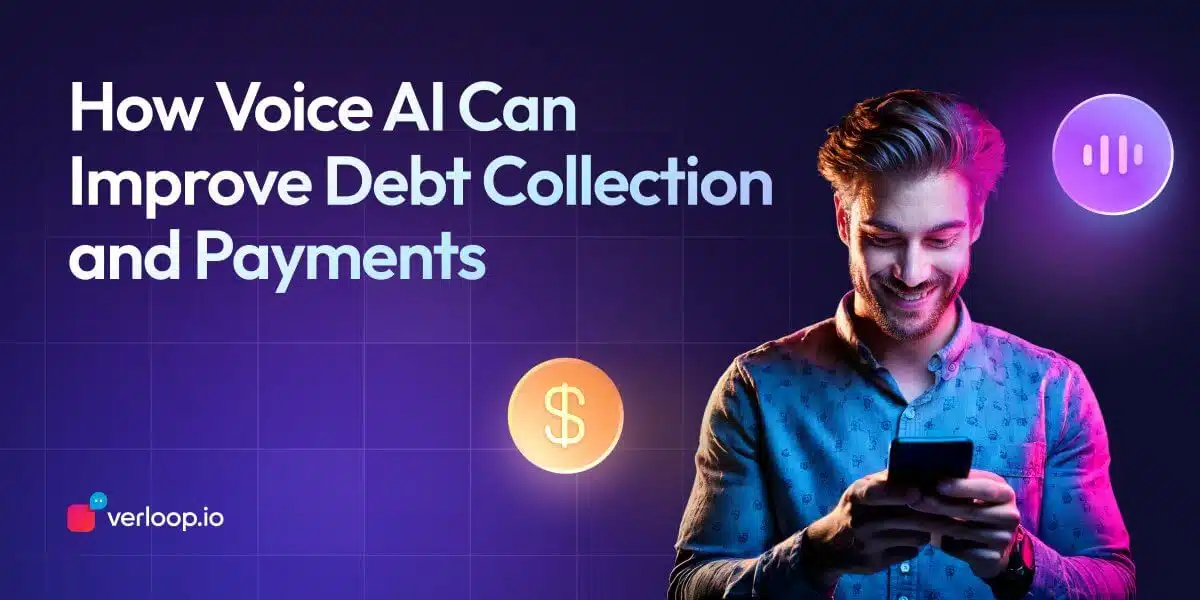
Evaluating Loan AI Voicebot Benefits, Use Cases and ROI in the Lending Industry
- February 27th, 2025 / 8 Mins read
-
Aarti Nair
In Q3 of the financial year 2024, the micro-lending sector recorded a gross loan portfolio of ₹3.85 trillion, underscoring the strong market demand for microloans. Across India, the overall loan market is estimated at approximately ₹198.3 lakh crore, with nearly 100 leading microfinance companies—including Bandhan Financial Services Limited, Annapurna Finance Private Limited, and Arohan Financial Services Limited—competing for market share. In such a competitive environment, enhancing the customer experience is critical; lenders who fail to offer same-day or next-day funding risk losing ground to more agile competitors.
Lenders often struggle with several challenges:
- Legacy Systems: Outdated processes slow down application reviews.
- Inefficient Data Collection: Manual verification methods hamper speed and accuracy.
- Limited Staff Availability: Handling after-hours applications becomes problematic.
- Compliance Complexity: Regulatory requirements add further delays.
Loan voicebots, or loan voice AI agents, provide a practical solution to these issues. By automating routine inquiries and streamlining application processing, these tools help improve customer service, reduce operational bottlenecks, and ultimately drive a better return on investment for lenders.
Generative AI-Powered AI Voicebots Deliver Human-Like Conversations for Lending Success
Imagine it’s late on a busy weekday and a potential borrower reaches out for a loan inquiry—while your office is already winding down, your loan voicebot is ready and waiting. Decision-makers at banks and loan-issuing institutes need solutions that work around the clock. Loan voicebots serve as a 24/7 lending companion, handling inquiries, initiating applications, and providing real‑time support—even when human staff are off duty.
With these AI-powered assistants, you can effortlessly streamline the application process, reduce waiting times, and ensure your customers never miss a beat. For instance, picture a scenario where a business owner urgently requires funding for an unexpected opportunity. Instead of waiting for office hours, they interact with your voice AI agent, which swiftly verifies their details, clarifies interest rates, and even offers personalised loan options—all within minutes. This not only boosts customer satisfaction but also enables you to secure more business, all while optimising operational efficiency.
For decision makers in lending institutions, the value proposition is clear: loan voicebots offer the chance to reduce operational bottlenecks, enhance support responsiveness, and maintain a competitive edge—all with a conversational, user-friendly interface that speaks directly to your customers’ needs.
Read more on how Voice AI Platform can improve customer support here.
Why Do Lending Institutions Need Voice AI?
1. Increasing Abandonment Rates
All banks and lending institutes are facing rising operational costs, fierce competition from agile digital-first NDFCs, a dipping economic market and a customer base that expects support at all hours and in multiple languages. Generative AI loan Voicebots—a smart solution designed to keep your service on par with modern demands while trimming unnecessary expenses. Let’s break down the key reasons you should consider integrating Voice AI into your operations.
Learn more about conversational banking.
Research indicates that customers who have abandoned financial services due to a slow application process have increased from 40% in 2016 to 68% in 2022.
Voice AI can provide immediate assistance, potentially reducing these abandonment rates.
2. Rising Costs of Operations
According to a study by the Freddie Mac group, loan origination costs have risen 35%, or $3,000. The average retail-only lender loses approximately $600 per loan today.
This highlights the need for cost-effective solutions like Voice AI to automate processes and reduce overheads. Legacy systems and manual processes can quickly drive up operational costs, eating into your bottom line.
By automating routine tasks and reducing the need for constant human intervention, AI loan Voicebots help you achieve up to a 20% reduction in support expenses. This means more efficient resource allocation and a leaner operation that delivers faster, more consistent service.
3. Competition from Digital-First NDFCs
A recent study found that in March 2024, companies disbursed 2.69 crore loans worth Rs 40,322 crore. It further noted that 70% of the disbursements were by 28 companies registered as non-banking finance companies. Digital-first lending institutions are rapidly capturing market share by offering faster, more responsive services.
Voice AI can help traditional lenders offer comparable digital experiences to compete effectively. If you’re still relying on outdated systems, you risk losing customers who prefer the speed and efficiency of modern platforms. Voice AI enables you to meet and even exceed these digital standards, ensuring that your institution remains competitive in an increasingly fast-paced market.
4. Extended Service Hours
Customers today expect round-the-clock support, yet traditional support centres often struggle to deliver. With AI loan Voicebots, you’re equipped with a 24/7 service channel on banking and loan applications, WhatsApp and any other channels that your customer prefers to handle inquiries even when your human team is off duty. This extended availability not only keeps your customers satisfied but also opens up new opportunities for processing applications at any hour—without extra staffing costs.
5. Need for Multilingual Support
Non-English-speaking customers often struggle to understand critical loan information, including agreements, disclosures, and fee structures. As your customer base becomes more diverse, offering support in multiple languages is no longer optional—it’s a necessity. Voice AI solutions can converse in various languages, ensuring that no matter where your customers come from, they receive clear and efficient service. This multilingual capability broadens your reach and reinforces your reputation as a customer-centric institution.
Implementing multilingual voice support helps lenders expand their customer base, reduce risks, and ensure fair access to financial services for diverse communities.
By curbing rising operational costs, keeping pace with digital-first competitors, providing around-the-clock service, and supporting a diverse, multilingual clientele, AI loan Voicebots help you deliver superior customer experiences while safeguarding your bottom line. Now is the time to consider how these intelligent solutions can fit into your overall strategy and drive your institution’s success.
How to Use Voicebots in Your Lending Process?
The lending process can be neatly divided into three essential phases: pre-approval, during approval, and post-approval. As someone steering your institution’s customer experience, you recognise that each phase plays a critical role in ensuring a smooth journey for your clients.
Imagine a prospective borrower interacting with a voicebot before even submitting an application—receiving instant information, answering preliminary queries, and setting the stage for a seamless application. During the approval phase, the voicebot supports your team by handling routine enquiries and keeping applicants informed in real time. And once approval is complete, it continues to serve, offering post-approval support that keeps customers satisfied and engaged.
Let’s explore how voice AI use cases fit into each of these phases, making your lending process more efficient and responsive.
Pre-Approval Phase
The pre-approval phase is the initial stage where potential borrowers first interact with your lending institution. This is the moment when customers seek clarity about eligibility, loan options, and the documentation needed to get started.
At this early point, providing quick and accurate information builds trust and sets the stage for a smooth application process. Voice AI solutiona can be invaluable here, answering queries instantly and guiding prospects through the preliminary steps before formal application begins.
1. Intelligent Loan Product Matching
Voicebots use machine learning algorithms to analyse a potential borrower’s financial profile and objectives.
By asking targeted questions and processing responses in real time, these systems can recommend the most suitable loan products from an institution’s portfolio.
For example, Bank of America’s virtual assistant, Erica, uses predictive analytics to offer personalised product recommendations. This intelligent matching not only improves customer satisfaction but also increases conversion rates.
2. Dynamic Pre-Qualification
Dynamic pre-qualification through voicebots represents a significant leap from traditional static online forms.
These AI-powered systems conversationally engage applicants, adapting their line of questioning based on real-time responses.
This creates a personalised, interactive experience that more closely mimics a human loan officer’s approach.
3. EMI and Interest Calculation
Voicebots quickly calculate EMIs and interest rates, providing accurate previews of loan repayment plans. This transparency helps align expectations between lenders and borrowers.
A study by J.D. Power found that clear communication of terms and conditions can improve customer satisfaction scores by up to 20 points in retail banking.
4. Financial Education and Literacy
Voicebots serve as on-demand financial advisors, explaining complex terms and concepts. This role is crucial, as financial literacy directly impacts loan performance.
The FINRA Investor Education Foundation reports that individuals with higher financial literacy are more likely to pay their loan instalments on time.
Voicebots can play a key role in improving this literacy, potentially leading to better loan outcomes for both borrowers and lenders.
Approval Phase
Once a potential borrower passes the initial pre-approval stage, they enter the approval phase—the heart of the lending process. This is when your institution verifies the details, assesses creditworthiness, and makes a definitive lending decision. In this phase, clear communication and timely updates are crucial to keeping both your team and your applicants in sync.
Voicebots shine during the approval phase by handling routine follow-ups, sending reminders for necessary documents, and providing real‑time status updates. This means that while your human experts focus on in-depth assessments and final decision-making, the AI seamlessly manages queries and keeps the process on track, ensuring that every application moves forward without a hitch.
1. Document Collection and KYC
Voicebots streamline the collection of documents for Know Your Customer (KYC) verifications. As your draft mentioned, they can also perform voice biometric verification or collect OTPs to authenticate user identity.
Research indicates that digital KYC processes can reduce onboarding times by up to 90% and cut costs by up to 70%.
An interesting trend is the integration of voice biometrics for identity verification, which adds an extra layer of security while simplifying the user experience.
2. Risk Assessment
Risk Assessment Augmentation While human underwriters make final decisions, voicebots assist by conducting preliminary risk assessments. They analyse verbal responses for sentiment and consistency, flagging potential risks.
For example: Ping An Bank in China uses a voicebot that analyses voice stress patterns during phone interviews to flag potential risk factors for human underwriters.
3. Fraud Detection
By analysing voice patterns and cross-referencing responses with application data, voicebots add an extra layer of security.
Take Barclays Bank for example. It implemented a voice biometrics system that analyses over 100 unique voice characteristics, successfully flagging synthetic voice fraud attempts.
4. Application Progress Tracking
Voicebots provide real-time updates on application status, explaining reasons for delays and providing estimated timelines for each stage of the process.
This transparency reduces customer anxiety and significantly decreases the volume of status-related calls to customer service centres.
Post-Approval Phase
Post-Approval Phase
After your lending decision is finalised, the post-approval phase takes centre stage in ensuring ongoing customer satisfaction and smooth loan management. This is where the focus shifts from processing the application to supporting borrowers throughout the life of their loan.
Voicebots here can provide real-time updates on payment schedules, answer ongoing queries about account details, and gather valuable feedback to help refine your services. In doing so, they help maintain a strong, long-term relationship with your customers, ensuring they remain engaged and well-informed every step of the way.
1. EMI Payment and Debt Recovery Reminders
Voicebots automate the process of sending payment reminders. This approach goes beyond simple reminders; it’s about influencing behaviour.
Modern voicebots use AI to create personalised, context-aware interactions. They analyse payment histories to determine optimal reminder times. The content and tone of messages adapt based on each borrower’s behaviour and circumstances.
For borrowers who fall behind, voicebots can conduct initial follow-ups, potentially reducing the need for human intervention in early-stage collections.
2. Continuous Credit Monitoring
Voicebots integrated with credit monitoring systems offer proactive financial management by continuously tracking borrowers’ credit profiles.
This goes beyond traditional periodic checks, providing real-time insights into a borrower’s financial health.
The voicebot can alert both the lender and the borrower to significant changes in credit scores, new credit inquiries, changes in debt-to-income ratios, or unusual spending patterns.
3. Feedback Collection
Voicebots can conduct post-loan surveys and analyse customer sentiment. This feedback loop is crucial for improving services.
The conversational nature of voicebots often leads to higher participation rates compared to traditional surveys.
4. Cross-selling Opportunities
Based on the borrower’s profile and repayment behaviour, voicebots can intelligently suggest additional financial products or services.
Boston Consulting Group reports that AI-driven cross-selling in banking can increase revenue per customer by up to 8%.
ROI Analysis of AI Loan Voicebot Implementations
Financial institutions implementing loan voicebots can expect a significant return on investment (ROI), driven by operational efficiencies, increased customer satisfaction, and expanded market reach.
Here are the stats to demonstrate the compelling return on investment financial institutions can expect from implementing loan voicebots:
Cost Savings
- Chatbots and voicebots in banking can save up to $7.3 billion in operational costs (Juniper Research).
- AI technologies, including voicebots, can potentially deliver up to $1 trillion of additional value each year in global banking (McKinsey & Company).
- AI technologies could reduce operating costs in financial institutions by 22% by 2030 (The Financial Brand).
Efficiency Improvements
- Banks can achieve a 2-5x increase in the number of interactions handled per hour with AI-powered solutions like voicebots (Accenture).
Revenue Enhancement
- Banks can increase their revenue by up to 6% within three years by integrating AI (Accenture)
- AI-driven personalisation in banking can boost a bank’s revenue by 5-15% (McKinsey & Company).
- Companies that have deployed AI-powered virtual customer assistants report a 70% reduction in call, chat, and email inquiries (Gartner).
Customer Satisfaction and Retention
- A 5% increase in customer retention can increase profits by 25% to 95% (Harvard Business Review).
- Highly satisfied banking customers are 2.5 times more likely to recommend their bank and 2.3 times more likely to stay with their bank (McKinsey & Company).
Cost Comparison
- Average cost per call handled by a human agent: $2.70-$5.60
- Average cost per interaction handled by a voicebot: $1-$2
Approve, Disburse, and Manage Loans with AI-powered Lending Voicebot
BFSI is the top sector truly embracing the wave of digital transformation. AI-led automation is not only helping lenders expedite loans but is also saving high operational spending.
With Verloop.io, you can build a voicebot that works precisely for YOUR lending business. Automate your most common user queries, set defined process flows that suit your needs, and manage your borrowers at scale.
Built on proprietary NLP and ASR, Verloop.io voicebots use speech as your best arsenal for automating most of your redundant or time-consuming lending processes. Schedule a demo with our team today to learn how you can do that for your business!
Frequently Asked Questions (FAQs)
1. Are Loan Voicebots Secure?
Loan voicebots typically employ advanced security measures such as encryption, secure data storage, and compliance with financial industry regulations like GDPR and PCI DSS. Many also use voice biometrics for additional security.
2. Can Loan Voicebots Handle Complex Loan Applications?
While loan voicebots can handle many aspects of complex applications, they are often designed to work in tandem with human loan officers. They can manage initial assessments, data gathering, and preliminary approvals, with complex cases being escalated to human experts.
3. What Types of Loans Can Be Processed Using Voicebots?
Loan voicebots can be used for various types of loans, including personal loans, mortgages, auto loans, and small business loans. The complexity and regulatory requirements of each loan type will determine the extent of voicebot involvement.







